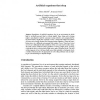Free Online Productivity Tools
i2Speak
i2Symbol
i2OCR
iTex2Img
iWeb2Print
iWeb2Shot
i2Type
iPdf2Split
iPdf2Merge
i2Bopomofo
i2Arabic
i2Style
i2Image
i2PDF
iLatex2Rtf
Sci2ools
80
Voted
ECAL
2003
Springer
2003
Springer
Artificial Organisms That Sleep
Populations of artificial organisms live in an environment in which light is cyclically present (day) or absent (night). Since being active during night is non-adaptive (activity consumes energy which is not compensated by the food found at night) the organisms evolve a sleep/wake behavioral pattern of being active during daytime and sleeping during nighttime. When the population moves to a different environment that contains "caves", they have to get out of a cave although the dark conditions of the cave may tend to induce sleep. We study various solutions to these problems: evolving a light sensor, evolving a biological clock, evolving both a light sensor and a biological clock. The best solution appears to be evolving a light sensor that modulates a biological clock, a solution which may also be appropriate to solve other problems such as adapting to seasonal changes in daytime length.
Related Content
| Added | 06 Jul 2010 |
| Updated | 06 Jul 2010 |
| Type | Conference |
| Year | 2003 |
| Where | ECAL |
| Authors | Marco Mirolli, Domenico Parisi |
Comments (0)

